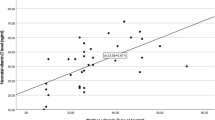Abstract
Plasma vitamin E levels were determined serially in preterm infants surviving respiratory distress syndrome (RDS) and in premature infants without RDS (control). Vitamin E intakes of the RDS and control infant group were not significantly different. The results of the study show that preterm infants surviving RDS have a persistent low plasma vitamin E level throughout the first 8 weeks of life. In contrast, in premature infants without RDS the plasma vitamin E level gradually increases to the adult level throughout the first 8 weeks of life. It is concluded that data on plasma vitamin E levels in premature infants with and without RDS should not be pooled together to obtain reference values. It is further suggested that premature infants with RDS might need more supplemental vitamin E than premature infants without RDS.
Similar content being viewed by others
Abbreviations
- RDS:
-
respiratory distress syndrome
References
Bell EF, Filer LJ (1981) the role of vitamin E in the nutrition of premature infants. Am J Clin Nutr 34:414–422
Gutcher GR, Raynor WJ, Farrell PM (1984) An evaluation of vitamin E status in premature infants. Am J Clin Nutr 40:1078–1089
Huijbers WAR, Oosterbaan JA, Meskendorp-Haarsma TJ, Hardonk MJ, Molenaar I (1979) An ultrastructural and cytochemical study of membrane alternations in X-irradiated liver tissue from normal and vitamin E deficient ducklings. Radiat Res 78:502
Molenaar I, Hulsteart CE, Vos J, Hommes FA (1973) The implication of the membrane localisation of vitamin E for its function, uptake and absorption. In: Jonxis JHP, Visser HKA, Troelstra JA (eds) Therapeutic aspects of nutrition. Fourth Nutrition Symposium. Stenfort Kroese, Leiden, pp 41–55
Pryor WA (1976) The role of free radical reactions in biological systems. In: Pryor WA (ed) Free radicals in biology, vol I. Academic Press, New York, pp 1–49
Sato S, Shimura S, Hirose T, Maeda S, Kawakemi M, Takhishima T, Kimura S (1980) Effects of long-term ozone exposure and dietary vitamin E in rats. Tohoku J Exp Med 130:117
Simon C, Kiosz D, Hofman I (1980) Serum concentrations of vitamin E in healthy infants fed commercial milks. Eur J Pediatr 133:273–276
Tangney CC, McNair HM, Driskell JA (1981) Quantitation of individual tocopherols in plasma, platelets, lipids and livers by high-performance liquid chromatography. J Chromatogr 224:389–397
Author information
Authors and Affiliations
Rights and permissions
About this article
Cite this article
Huijbers, W.A.R., Schrijver, J., Speek, A.J. et al. Persistent low plasma vitamin E levels in premature infants surviving respiratory distress syndrome. Eur J Pediatr 145, 170–171 (1986). https://doi.org/10.1007/BF00446056
Received:
Accepted:
Issue Date:
DOI: https://doi.org/10.1007/BF00446056




